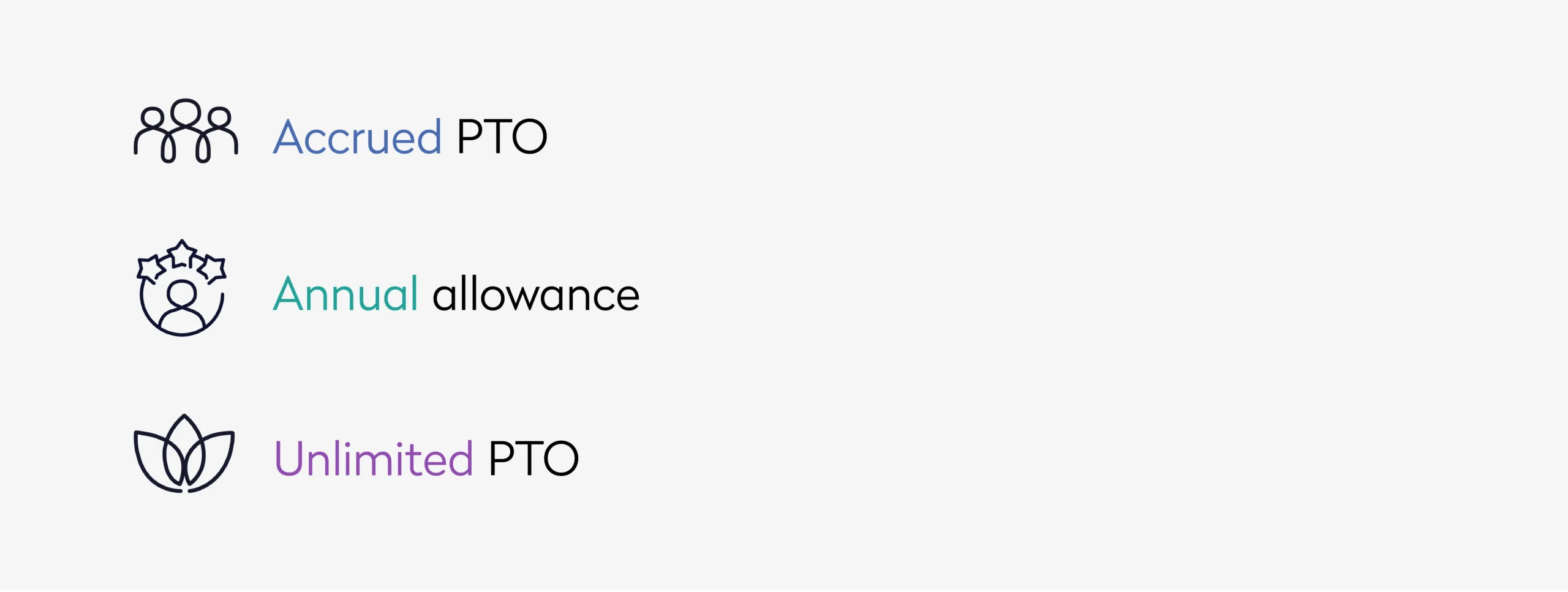
Are you ready for a summer full of vacations? Taking time off during summer is highly beneficial for businesses and workers. However, when managing multiple employees, you want to ensure that priority projects don’t fall through the cracks.
If you’re taking paid time off (PTO), the last thing on your mind should be working. But if you’re a manager and a member of your team is out of the office, there should be no need to contact them.
Time off is only as enjoyable as the preparation. Summer is a wonderful time to look at your PTO policies. As you navigate summer, learn how to effectively manage and encourage your team to take time off.
Different types of PTO
PTO is a great tool to ensure employees can rest, recharge, and enjoy life outside the office and work. Salaried employees can earn or accrue time off without losing their regular pay.
But not all PTO compensation packages look the same. For example, some companies include sick days as a part of an employee’s annual PTO while others consider sick days as a separate category. Regardless of the specifics, each PTO policy has its pros and cons.
Let’s look at the most common types of PTO:
Accrued PTO
With accrued PTO, employees earn time off according to the time they’ve worked – typically quarterly or monthly. Your payroll provider will use a paycheck calculator to determine an employee’s accrual amount based on pay frequency and salary.
The downside to this policy is that some employees may not have accrued enough PTO for their summer vacation depending on factors such as start date and length of vacation. To counter this, some employers allow for negative PTO, enabling employees to use PTO they haven’t accrued yet and earn it back after returning. If an employee leaves the company before earning back the PTO, it becomes docked from their final paycheck.
Annual allowance
The annual allowance method, also referred to as a lump sum PTO policy, offers a fixed amount of time of PTO per year. When the annual allowance resets depends on your organization – the employee hire date, the calendar year, or your company’s fiscal year.
This package appeals to job candidates because the days are provided simultaneously. This lump sum strategy is especially great for lengthy vacations when the policy allows unused PTO to roll over to the following year. Additionally, the longer workers remain at their company, the more annual PTO days they receive.
Unlimited PTO
Unlimited PTO refers to employees not being restrained to a minimum amount of PTO days. However, it operates under the expectation that employees will take time off when needed without abusing the lack of limitations.
Interestingly, employees with unlimited PTO often take less PTO than those with accrued or annual policies. Why? Because of the accountability factor and perception that time off is less deserved. Companies can combat this by adding a minimum mandatory time off. With this, employees will feel more supported when taking vacation time.
Best practices for encouraging summer PTO
Summer is one of the most demanding times for managers in charge of PTO approvals and day-to-day enforcement. However, with the following tips, you can avoid potential headaches while encouraging your team to take time off.
Set expectations in advance
Not every company handles PTO approvals the same way. So, it’s important to give clarity and communicate your PTO process to your team. This way, employees will know exactly what to expect before making time-off requests. For example, do you plan to approve all submissions automatically or will you have a ‘first-come, first-serve’ policy? Will any summer dates be blocked from PTO due to important company events?
When preparing for an influx of vacation requests, consider requiring an early deadline, where workers must submit all summer PTO by a specific date. Of course, choose a reasonable deadline based on business demands and employees’ ability to plan. Additionally, if there are blackout periods where employees cannot take vacations, make these known far in advance so it doesn’t come as a surprise.
Discourage working while on PTO
Hustle culture encouraged professionals to work while on their time off. Employees frequently responded to emails and messages during their vacations because of the urgency placed on them. Thankfully, hustle culture is no longer the norm. Reiterate to your team that when they are on PTO, it’s genuinely their time off, and they are not to work. Guarantee their workloads are covered and well-managed to eliminate any reason for concern.
Ultimately, how seriously your team takes this policy depends on the tone you set. Leadership should also not work while on vacation. Employees look to you to set the precedence, so lead by example.
Make employees feel comfortable
Before the pandemic, organizational cultures subtly insinuated that employees who took the least time off were top performers. We now know this isn’t true. Research shows there is a direct link between time off and improved productivity. Requesting PTO doesn’t make employees less loyal or devoted to the company than those that don’t. If anything, not taking vacations leads to quicker employee burnout.
Make your employees feel comfortable planning summer vacations and taking time off. Encourage them to take time to rest, recharge and disconnect from work. Professionals with leadership who prioritize their mental health and work-life balance are the real top performers.
Summer vacations prevent burnout and increase productivity
Countless studies now emphasize the importance of taking regular work breaks and time off. Summer vacations offer a unique opportunity for extended rest, allowing employees to detach from work-related stressors and immerse themselves in leisure activities. In Europe, professionals are encouraged to maximize their PTO during August – often for multiple weeks at a time. Employees who make the most of their time away from work return with improved productivity and overall job performance.
With this said, there are still employees who don’t take enough advantage of their PTO. In a recent Pew survey, 46% of American professionals reported taking less time off than offered leaving them plenty of unused vacation and PTO hours.
Here’s why:
- 52% feel they don’t need to take more time off
- 49% worry they will fall behind at work
- 43% feel bad about having co-workers take on their workload
- 19% think taking more time off might hurt their chance of career advancement
- 16% think they might risk losing their job.
- 12% reported that their manager discourages them from taking time off
Leadership should normalize employees taking time off in the summer. Before the pandemic, workers felt they needed a good reason to request PTO. However, with employee burnout on top of mind, today’s workplace encourages workers to use their PTO – no matter the reason. Whether it’s for a vacation or a staycation, time off in the summer should be welcomed with open arms.
As for the employees who work through the summer months, you can still support them by relaxing office policies. For example, if your hybrid model requires employees to come into the office Monday through Wednesday, offer your team to choose the days they go in or shorten the days needed to work in the office. Another popular method is to provide half-day Fridays up until September. Ultimately, the goal is to make accommodations for employees during summertime to benefit their mental and physical well-being.
Create a culture of PTO
Fostering a culture where employees feel comfortable taking PTO is imperative. Relay the message that when employees take time off, they show their commitment to the job. How? They are avoiding burnout and recharging mentally and physically during their vacation time.
Effectively manage and encourage your team to use their vacation time. And for those that don’t, support them with more flexible office policies. PTO is integral to today’s workplace culture whether employees work remotely, hybrid, or in the office. Time off is a win-win for employees and the business with employee health enriched and productivity increased.








